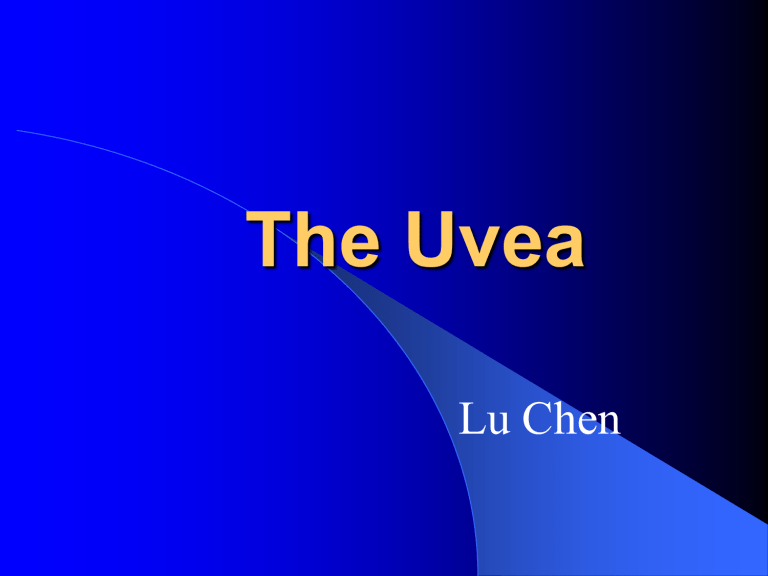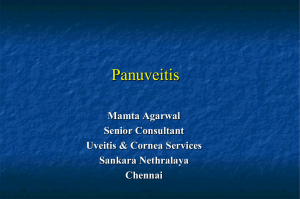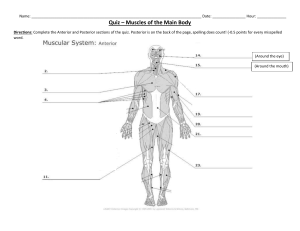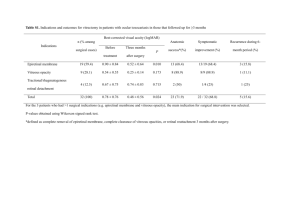
The Uvea Lu Chen Choroid The choroid is the posterior segment of the uveal tract, between the retina and the sclera. It is composed of three layers of choroidal blood vessels: large, medium, and small. The deeper vessels are placed in the choroid, the wider in their lumens. Uveitis The uveitis is a common ophthalmopathy which is an inflammation of uvea caused by multiple reasons. Characters commonly occurred in youth both eyes are involved relapsing disease a common ophthalmopathy leading to blindness Iridocyclitis It is an inflammation mainly caused by endogenous or related to systemic diseases besides injury, surgery and injection. Symptom Pain, photophobia Visual decrease Sign Ciliary or mixed congestion Opaque aqueous humor: Tyndall sign is positive. It is an important sign of anterior uveitis and active inflammation. Keratic precipitate(KP) -- fine dusty KP -- “Mutton fat” KP -- pigmentary KP -- hyaloid KP 1.Ciliary or mixed injection 2.Aqueous flare 3.Keratic precipitates(K.P) 3.Keratic precipitates(K.P) Sign Change of the pupil Change of the iris blurred markings, peripheral anterior synechia, iris nodules Vitreous opacity Cystoid macular edema or optic nerve head edema can be seen when posterior segment is normal. plum blossom pupil Seclusion of pupil Occlusion of pupil Koeppe’s nodular Busacca’s nodular Complications Secondary glaucoma: Due to aqueous outflow is impeded or papillary block, and blindness occurs in severe cases. Complicated cataract: Normal physiological metabolism of the lens is effected and cause complicated cataract. Low IOP and atrophy: The generation of aqueous humor decreases which is easy to arouse low IOP in early stage of illness. If the inflammation continues for a long time, it may induces globe atrophy. Diagnosis Ciliary congestion, opaque aqueous humor, KP, pupil constricted, posterior synechia of iris, pain of ciliary and vitreous opacity. Opaque aqueous humor and KP are more important. Differential diagnosis acute conjunctivitis acute angle-closure glaucoma intraocular tumor: It can be distinguished by history examination. Treatment Local treatment: --- mydriasis: to prevent posterior synechia of the iris and decrease complications. --- Corticosteroid: local instillation or local injection. Treatment Systemic treatment: --- corticosteroid: used in severe stage or long history --- anti-prostaglandin drug: like inducine etc. --- treatment to etiology Treatment to complications: Operation to secondary glaucoma and complicated cataract will be performed after inflammation is controlled. Middle uveitis It is an inflammation and proliferative disease which takes place at pars plana, serrate and peripheral retina primarily, often bilateral, and with character of latent onset and chronic course. Symptom Latent onset, common symptom is fogging vision. Visual decreases when complications occurs. Sign It is an inflammation takes place at middle uvea by three-mirror and indirect ophthalmoscope examination. Change of anterior segment: There has no or slight change commonly, and sign of iridocyclitis can be seen in youth. Sign Change of vitreous and pars plana: A lot of white or yellow-white bank exudates can be seen at inferior pars plana which is the character of the disease. Change of retina: There may be retinal vasculitis or perivasculitis which may extend to posterior pole, the blood vessles become occlusion like white thread. Choroidal atrophy , pigmental alteration and papilledema can be seen in some cases. Complications Cystoid macular edema: It is the mainly reason of visual decrease. Complicated cataract: It is often opacitive at subcapsule. The onset is slow which related to inflammation and corticosteroid. Diagnosis: topical sign Snow bank exudate at inferior pars plana Vitreous opacity Phlebitis or periphlebitis in the retina Differential diagnosis Irvine-Gass syndrome vitreous opacity acute retinitis acute retinal vasculitis amyloid degeneration Behcet disease others Treatment The cause is unclear so there has no effective treatment now. The necessary treatment would be given when visual acuity below 0.5 or visual acuity beyond 0.5 but with lots of floating opacity in vitreous. Treatment local treatment: local instillation or local injection systemic treatment: corticosteroid and immunotherapy should be given in severe cases. operation: cold-coagulation, vitrectomy Posterior uveitis(Choroiditis) It is an inflammation at choroid, posterior vitreous and retina. For anatomy basis, inflammation often invades into retina. Symptom There may be not any symptom if only peripheral focal part is involved in. when the posterior diffuse inflammation invades into macular, floating black shadow before eye, flashing, metamorphopsia and blurred vision occurs. Sign It is often normal in anterior segment and KP may be seen when ciliary involved. Vitreous opacity: Vitreous opacity situated in posterior part like dust or cotton and the fundus is not very clear. Sign Acute stage: --- Focal or diffuse yellow-white exudation at fundus with blurred border and various size; --- Retina edema; fluorescence leakage in FFA and hyperfluorescence in anaphase. --- Vitreous opacity: situated in posterior part like dust or cotton and the fundus is not very clear. Sign Scar stage: After some weeks to some months, exudation patchs begin to absorb. --- Patchs become yellow-white or grey-white with clear border. --- Pigmented spots in it and periphery is surrounded by pigment. --- Some funduses look like brown-red appearance of sunset glow, sclerotic choroidal blood vessels or exposed white scleral tissue after destruction of vascular layer in large focus. Complications serosity retinal detachment retinal vasculitis, perivasculitis Etiology: complicated infection: circle worm, capsule worm, virus etc. non-infection: sympathetic ophthalmitis etc. Treatment Treatment to etiology systemic treatment Anti-infection: Corticosteroid should be given but more attention should be paid to other side effects during administration. Panuveitis The iris, the ciliary body, the choroids are closely connected not only in anatomy, but also belong to the same blood source in blood supply. Panuveitis is called as all parts are involved. About etiology, symptom and treatment of panuveitis reference to the previous chapters. Some Specific Type Uveitis Sympathetic ophthalmia Concept: It is the eye which got perforating injury or intraocular operation( called exciting eye) undergoes a period of non-purulent uveitis then in another eye, the uveitis with the same character takes place which is called sympathizing eye. Etiology: the cause is unknown Clinical situation Exciting eye: --- Relapse of inflammation in anterior segment of the eye or original inflammation becomes severe.; --- The fundus: congestion of optic nerve head; edema in posterior pole and serosity retinal detachment. Sympathizing eye: --- Anterior segment: anterior uveitis --- Fundus: hyperemia of optic nerve head; edema in surround retina; yellow-white exudation and serosity retinal detachment. It looks like sunset glow after some months of onset. --- FFA --- Complications: cataract, glaucoma, retinal detachment, optic nerve atrophy Treatment Management of perforating eye injury must be correct. If sympathetic ophthalmia takes place, the course of the sympathizing eye will not be influenced even the exciting eye was enucleated. But following points should be considered: The damage of injuried eye is severe and there has no hope to restore vision. Complicated with secondary glaucoma, the IOP can not be controlled. There has no effect of conservative treatment, chronic inflammation relapses again and vision of injuried eye had been lost. Corticosteroid and mydriasis Acute retinal necrosis syndrome Acute retinal necrosis is a syndrome includes acute necrosis retinitis, retinal vasculitis, and retinal detachment which caused by virus. Clinical situation Pain of orbit, scleritis, anterior uveitis at first. Vitreous exudation, necrosis retinitis and visual decreased soon. Complicated with retinal detachment. Pigment deposition can be seen at the posterior border of retinal lesion when inflammation relieves, even PVR occurs. Diagnosis clinical situation and lab findings Treatment It has no effective treatment now. Anti-virus Anticoagulant Vogt-Koyanagi-Harada syndrome General description: VKH is a syndrome which involves multiple organs and systems, like eyes, ears, skin and meninges. The diffused serosity uveitis of both eye can be found, accompanied with headache, tinnitus,baldness, vitiligo etc. Etiology: Unknown. It maybe a immunologic reaction to retinal pigment epithelium. Clinical situation headache, tinnitus etc. visual decreases of both eyes fundus: edema of posterior pole, serosity retinal detachment, edema of optic nerve head, vitreous body opacity and anterior uveitis. Clinical situation VK: the symptom of VK just like acute anterior uveitis. Harada disease: the symptom just like sympathetic ophthalmia and visual decreases of both eyes. FFA systemic diseases fundus: looks like sunset glow complications: complicated cataract, secondary glaucoma, and serosity retinal detachment. scrappy leakage spots Treatment Anti-inflammation: Corticosteroid as soos as possible. Treatment according to the disease. Behcet disease a chronic relapsing syndrome, consists of uveitis, ulcer of mouth, ulcer of genital organ, skin lesion, arthrositis and nervous system lesion. commonly occurred in male at age of 20-40 both eyes are involved mostly. Etiology: Unknown. It maybe a multiple systems and organs disease caused by immunocomplex. Clinical situation posterior uveitis posterior segment: retinal vasculitis anterior segment: non-granulomatous uveitis Clinical situation complications: complicated cataract, secondary glaucoma and optic nerve atrophy. extraocular symptom: relapsing ulcer of mouth, ulcer of genital organ, skin lesion, arthrositis and optic nerve atrophy. Clinical findings 1.Lesion of the eyes Clinical findings 2.Oral ulcer Clinical findings 3.Lesion of the skins Diagnosis relapsing ulcer of mouth, three times in a year at least diagnosis by any two followed: --- relapsing ulcer of genital organ or scar of genital organ --- ophthalmologic lesion --- skin lesion --- hypersensitivity of skin Treatment very hard, immunologic treatments are applied. Drug Plasma exchange Laser treatment Treatment according to complications Tumor of the Uvea Iris nevus A benign tumor at surface of iris, brown, smooth and with clear border. commonly occurred in male at age of 20-40 If the colour becomes deep or the area of nevus becomes larger, it is the omen of canceration. Excision by surgery is necessary. Follow-up strictly. Iris cyst Etiology: congenital, inflammation, serosity, parasitic and trauma Implantation cyst is common during perforating injury or intraocular operation. Follow-up strictly. During its developing course, pupil may be pushed to a side, even resulted in glaucoma. Excising by surgery is necessary. Choroidal osteoma Benign tumor and grows slowly commonly occurred in young female yellow-white or orange and with blurred border which is near by optic nerve head FFA, B-scan and CT are helpful to diagnosis Follow-up strictly or laser treatment





